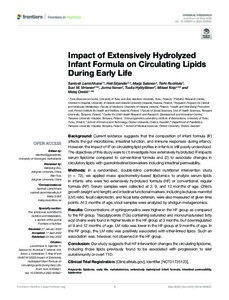Impact of Extensively Hydrolyzed Infant Formula on Circulating Lipids During Early Life
Lamichhane Santosh; Siljander Heli; Salonen Marja; Ruohtula Terhi; Virtanen Suvi M.; Ilonen Jorma; Hyötyläinen Tuulia; Knip Mikael; Orešič Matej
https://urn.fi/URN:NBN:fi-fe2022091258561
Tiivistelmä
Background: Current evidence suggests that the composition of infant formula (IF) affects the gut microbiome, intestinal function, and immune responses during infancy. However, the impact of IF on circulating lipid profiles in infants is still poorly understood. The objectives of this study were to (1) investigate how extensively hydrolyzed IF impacts serum lipidome compared to conventional formula and (2) to associate changes in circulatory lipids with gastrointestinal biomarkers including intestinal permeability.
Methods: In a randomized, double-blind controlled nutritional intervention study (n = 73), we applied mass spectrometry-based lipidomics to analyze serum lipids in infants who were fed extensively hydrolyzed formula (HF) or conventional, regular formula (RF). Serum samples were collected at 3, 9, and 12 months of age. Child's growth (weight and length) and intestinal functional markers, including lactulose mannitol (LM) ratio, fecal calprotectin, and fecal beta-defensin, were also measured at given time points. At 3 months of age, stool samples were analyzed by shotgun metagenomics.
Results: Concentrations of sphingomyelins were higher in the HF group as compared to the RF group. Triacylglycerols (TGs) containing saturated and monounsaturated fatty acyl chains were found in higher levels in the HF group at 3 months, but downregulated at 9 and 12 months of age. LM ratio was lower in the HF group at 9 months of age. In the RF group, the LM ratio was positively associated with ether-linked lipids. Such an association was, however, not observed in the HF group.
Conclusion: Our study suggests that HF intervention changes the circulating lipidome, including those lipids previously found to be associated with progression to islet autoimmunity or overt T1D.
Kokoelmat
- Rinnakkaistallenteet [27094]
